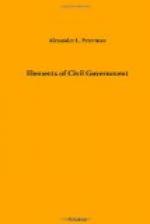DEFINITION.—A State is a community of free citizens living within a territory with fixed limits, governed by laws based upon a constitution of their own adoption, and possessing all governmental powers not granted to the United States. Each State is a republic and maintains a republican form of government, which is guaranteed by the United States. The State is supreme within its own sphere, but its authority must not conflict with that of the national government. A State is sometimes called a commonwealth because it binds the whole people together for their common weal or common good.
FORMATION OF ORIGINAL STATES.—The thirteen original colonies were principally settled by people from Europe. The colonial rights were set forth and boundaries fixed by charters granted by the crown of England. In the Declaration of Independence these colonies declared themselves “free and independent States.” After the treaty of peace which acknowledged their independence, they framed and adopted the national constitution, and thereby became the United States of America.
ADMISSION OF NEW STATES.—New States are admitted into the Union by special acts of the Congress of the United States. An organized Territory having the necessary population sends a memorial to Congress asking to be admitted as a State. Congress then passes a law called an “enabling act,” authorizing the people of the Territory to form a State constitution. When the people have framed and adopted a State constitution not in conflict with the Constitution of the United States, Congress passes another act admitting the new State into the Union “upon an equal footing with the original States in all respects whatever.” Sometimes the enabling act provides for admission on proclamation of the President of the United States. Several of the Territories adopted State constitutions and were admitted as States without enabling acts.
PURPOSES.—The State keeps power near the people, and thus makes them more secure in their liberty. “The powers not granted to the United States, nor prohibited to the States, are reserved to the States respectively or to the people.” If the whole country were a single republic without State divisions, power would be withdrawn from the people and become centralized in the national government.
Our political system leaves the various functions of government to the smallest political communities that can perform them efficiently. The county has charge of all public interests that can be managed by it as well as by the State. Many public affairs, such as popular education,[1] private corporations, and the organization of the smaller political divisions, can be better managed by the State than by the National Government, and are therefore properly left to the State’s direction.
Parts of the country widely separated differ in climate and soil, giving rise to different industries and occupations, which require different laws, made and administered by different States. The State serves as a convenient basis for the apportionment of members of both houses of Congress, and State institutions preserve and develop the local individuality and self-reliance of the people.




